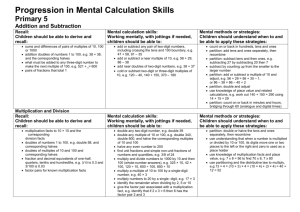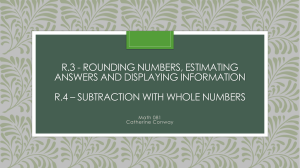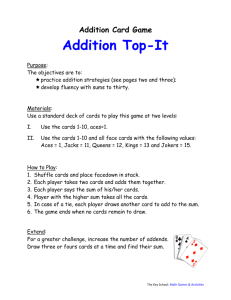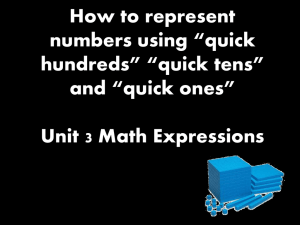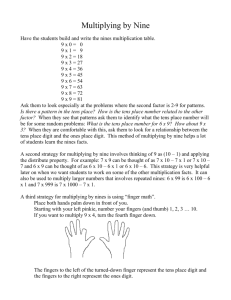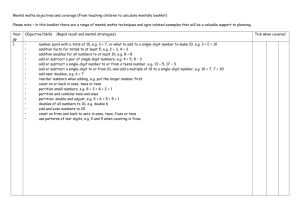Third_Grade_Fact_Strategies
advertisement
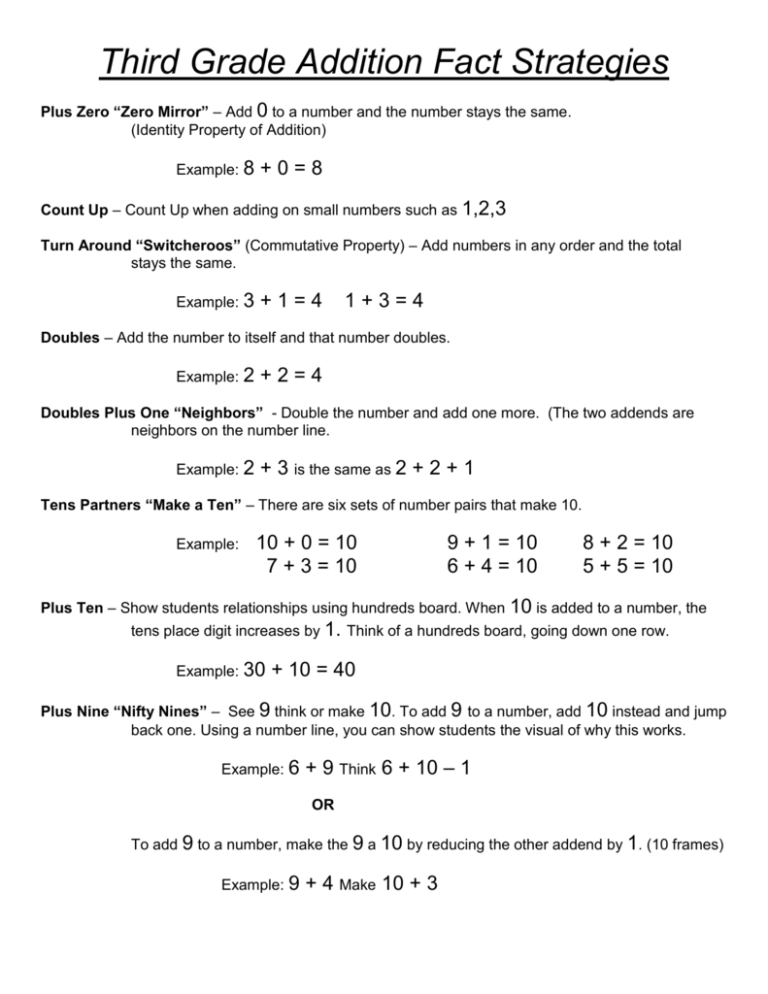
Third Grade Addition Fact Strategies Plus Zero “Zero Mirror” – Add 0 to a number and the number stays the same. (Identity Property of Addition) Example: 8 +0=8 Count Up – Count Up when adding on small numbers such as 1,2,3 Turn Around “Switcheroos” (Commutative Property) – Add numbers in any order and the total stays the same. Example: 3 +1=4 1+3=4 Doubles – Add the number to itself and that number doubles. Example: 2 +2=4 Doubles Plus One “Neighbors” - Double the number and add one more. (The two addends are neighbors on the number line. Example: 2 + 3 is the same as 2 + 2 + 1 Tens Partners “Make a Ten” – There are six sets of number pairs that make 10. Example: 10 + 0 = 10 7 + 3 = 10 9 + 1 = 10 6 + 4 = 10 Plus Ten – Show students relationships using hundreds board. When 8 + 2 = 10 5 + 5 = 10 10 is added to a number, the tens place digit increases by 1. Think of a hundreds board, going down one row. Example: 30 + 10 = 40 Plus Nine “Nifty Nines” – See 9 think or make 10. To add 9 to a number, add 10 instead and jump back one. Using a number line, you can show students the visual of why this works. Example: 6 + 9 Think 6 + 10 – 1 OR To add 9 to a number, make the 9 a 10 by reducing the other addend by 1. (10 frames) Example: 9 + 4 Make 10 + 3 Extension Strategies (to be taught AFTER above strategies are mastered when students are developmentally ready in number sense.) Doubles Plus Two - Double the number and add two more. Example: 5 + 7 is the same as 5 + 5 and 2 more or 12 Plus Eight – See 8 think or make 10. To add 8 to a number, add 10 instead and jump back two. Using a number line, you can show students the visual of why this works. Example: 6 + 8 Think 6 + 10 – 2 OR To add 8 to a number, make the 8 a 10 by reducing the other addend by 2. Ten frames Work great to how this visually. Example: 8 + 4 Make 10 + 2 Add in Small Steps - Split the smaller number into two parts (this is called decomposing a number) so that you can add to a multiple of 10. Example: 26 +7=? 1. The Tens Partner for 26 is 4. 2. Split the smaller addend, 7, into (4 3. 4. + 3). Add the Tens Partners Numbers 26 + 4 = 30. Then add the remaining number 30 + 3 = 33 Hidden Facts – Finding tens partners and doubles hidden within problems can make them easier to solve. Hidden Tens Partners Hidden Doubles 8 + 6 = (8 + 2) + 4 6 + 8 = (6 + 6) + 2 = 10 + 4 = 12 + 2 = 14 = 14 Plus 20 – When you add 20 to a number, the tens digit increases by 2. Plus 19, Think 20 – For Plus 19, add 20 then subtract 1. Plus 99, Think 100 – For Plus 99, add 100 then subtract 1. Third Grade Subtraction Fact Strategies Think Addition - Remind students of the relationship between addition and subtraction. These are the fact family members from the addition facts they know. Example: 13 –6= so think + 6 = 13 Minus Zero “Zero Mirror” – Subtract 0 from a number and the number stays the same. Example: 8 -0=8 Number Minus Itself “Numbers the Same” - Subtract a number from itself and the result is I use the rhyme “If the numbers are the same, zero’s the name.” Example: 8 0. -8=0 Count Back – Count back to take away small numbers such as 1, 2 or 3. Use a number line to show students the relationship and visual of what they are doing. Example: 9 – 2 = 7 Start at 9 and count back 2. Count Up - Count Up to find the difference when the numbers are close together. Example: 11 – 9 = 2 Count up from 9 to 11. Doubles – If you know the addition doubles, then you know the related subtraction fact. Example: 2 + 2 = 4 so 4 – 2 = 2 Tens Partners “Make a Ten” – If you know the six sets of number pairs that make 10, then you know the related subtraction facts. This is a great opportunity to use ten frames to show visual. Example: 9 + 1 = 10 so 10 – 1 = 9 Minus Ten – Show students relationships using hundreds board. When 10 is subtracted from a number, the tens place digit decreases by 1. Think of a hundreds board, going up one row. Example: 30 - 10 = 20 Minus Nine “Nifty Nines” – Remember that 9 is just one away from 10. See 9 think or make 10. Example: 12 Example: 12 - 9 Think 12 - 10 + 1 -9 OR Think 13 - 10 Extension Strategies (to be taught AFTER above strategies are mastered when students are developmentally ready in number sense.) Minus Eight – Remember that 8 is just two away from 10. See 8 think or make 10. Example: 15 - 8 Think 15 - 10 + 2 OR Example: 15 - 8 Think 17 - 10 Subtract In Small Steps – Split the number being subtracted into two parts. (This is called decomposing numbers) so that you can subtract to 10 or a multiple of 10. Example: 24 – 7 = ? – 4 = 20 2. So split the 7 into 4 and 3 1. 24 3. Then apply the Tens Partners to subtract 4. 20 3 from 20. – 3 = 17 Minus 20 - When you subtract 20, the tens place digit decreases by 2. Minus 19 – Subtract 20 then add 1. Minus 99 – Subtract 100 then add 1.

